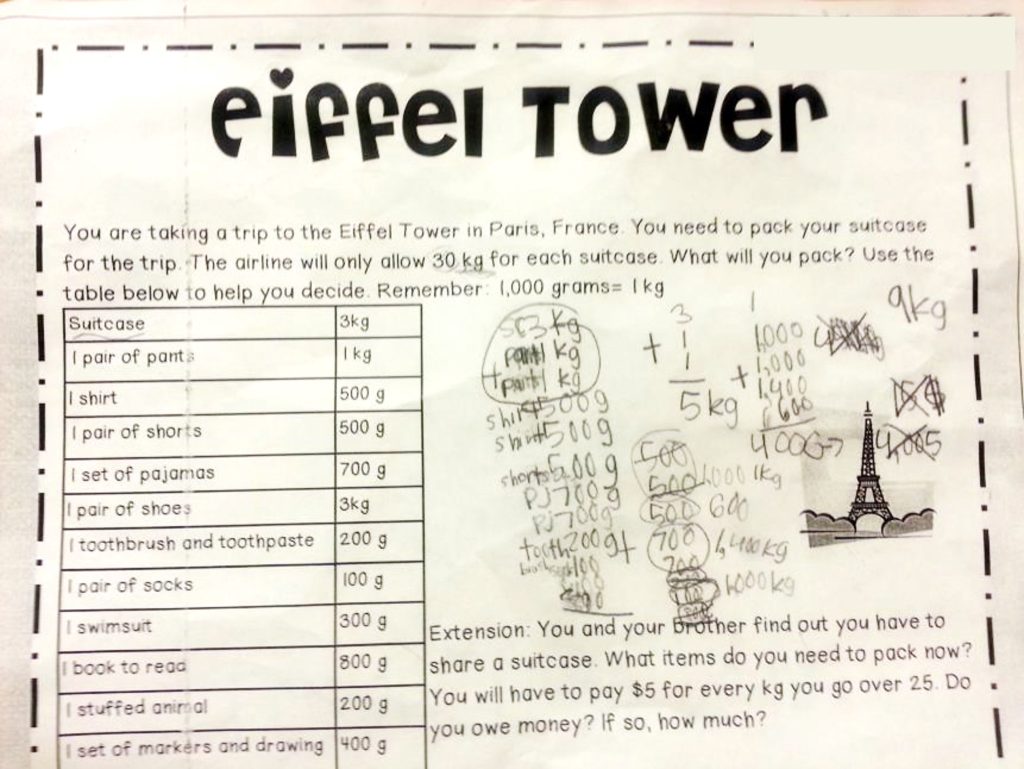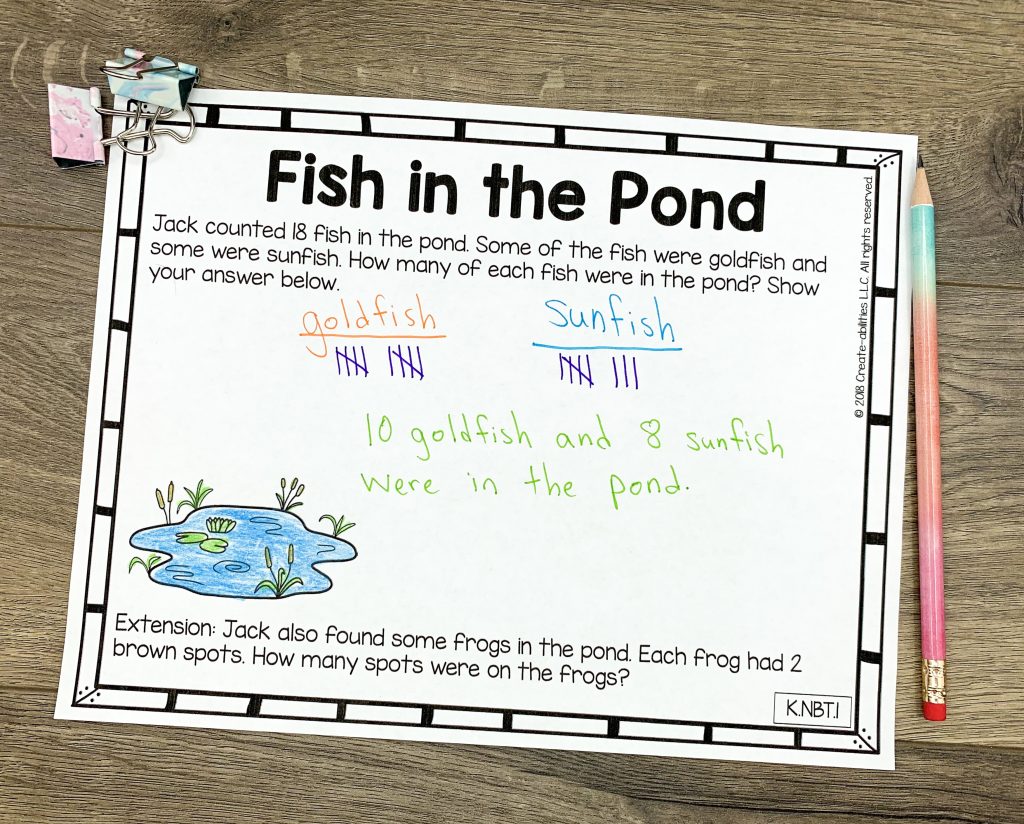
Open-Ended Math Tasks Part One: What, Why, and When?
“Your parents are finally letting you put up a swing set in your backyard. Before the swing set goes in, you need to plant grass. Do you measure in feet, inches, or meters? How much grass will you need to go under your new swing set?”
If this third-grade open-ended math task stresses you out, you are not alone! When I first read problems like these, I had a lot of questions. Where are the numbers? How do I know if the kids have the right answer? ARE there right answers?
I had tons of questions and really didn’t see how these types of tasks could be useful in teaching math. But I did do a bit more research and (reluctantly) decided to give them a try. After a while, I realized open-ended math tasks could actually be an excellent complement to my math instruction and decided to make these open-ended math tasks work for me.
If you are looking for a way to increase the depth of thinking in your math instruction, you might also want to consider using open-ended math tasks. To save you the trouble of trying to figure out the basics of these tasks, I have compiled some of the basic information here. Read through, and decide if you think these types of tasks could work in your classroom!
What are Open-Ended Math Tasks?
So as you can see from the sample task, an open-ended math task is really just a specially designed word problem to have more unknowns, and less knowns. Now, not all of these tasks need to have as much missing information as the one above. You can design them in a way that supports your instruction and your learners. There are really three major characteristics that define open-ended math tasks.
- Multiple Points of Entry: Open-ended math tasks have multiple points of entry, making it possible for the entire class to be working on the same math task. In other words, students are able to complete the problem in a way that meets them at their current level. They will be working in their own zone of proximal development because they are responsible for supplying those “unknowns”, and can do so at a level that matches their ability.
Looking at the sample above, you can see that students have some decisions to make. They could choose to work in feet, inches or meters. They will also need to decide how long and wide their swing sets will be. Students will quickly realize that the larger the numbers they are working with (or the smaller the unit), the harder the work will be. I have found that students will usually start with a number they feel comfortable with, especially after they gain more experience with these tasks. If they do start with a number that is too difficult for them to work with, they can easily go back and revise their data. This allows for instant differentiation, which is a definite plus in my book!
- Multiple Answers: All open-ended math tasks have multiple correct answers. This makes sense since students are supplying their own individual numbers and data in the problems. It does require a shift in our thinking as teachers, but it can also relieve some stress on our students. We are shifting the emphasis from the correct answer to the problem-solving process. When students know they are getting evaluated on their method more than the actual answer, it seems easier to try without being overly anxious about making a mistake.
So again looking at the sample, you may have students who decide to draw a diagram to aid their solution. Others may use formulas, and some may use repeated addition. Some may use a combination of strategies. All of these approaches are appropriate, and give you some great insight into each student’s math thinking.
- Rooted in Real-World Scenarios: The best way to help our students connect to any concept is to connect it to their world and life experiences. This helps them build meaning and solidify their learning. Open-ended math tasks are no exception. Creating problems about real-life scenarios that they can relate to will help develop both interest and understanding.
This is apparent with the swing set problem. It presents a real world situation which many of our students can relate to. I mean, who doesn’t love to swing? Now depending on where you are working you may change it to represent a park getting a new swing set rather than each individual student’s yard, but the idea is the same. Open-ended math tasks engage our students at a higher level by asking them to use math to solve real-life problems in the world around them.
Why Should I Use Them? As I said, I knew open-ended math tasks had worked well for another teacher in my school, but I still wasn’t sold. I mean, she was a very effective math teacher so maybe it was more about her and less about the tasks. So I did a bit of my own research before implementing them into my math block. And, while it is certainly true that her dynamic teaching was critical to her students’ success, there is a great deal of research to support the use of open-ended math tasks.
The National Research Council released a research paper in 2001 named Adding It Up: Helping Children Learn Mathematics. This research emphasized the idea that mathematical proficiency was more than simply following set formulas to arrive at the correct answer, and laid the groundwork for the Common Core Standards. The Common Core then set out eight standards for mathematical practices (CCSSO, 2010):
- Make sense of problems and persevere in solving them.
- Reason abstractly and quantitatively.
- Construct viable arguments and critique the reasoning of others.
- Model with mathematics.
- Use appropriate tools strategically.
- Attend to precision.
- Look for and make use of structure.
- Look for an express regularity in repeated reasoning.
While it is apparent how open-ended math tasks support all of these skill strands, perhaps the most direct connection is to “construct viable arguments and critique the reasoning of others”. Since there are multiple answers, kids are naturally discussing whose answer is correct and why! This allows them to begin critiquing each other’s work in a respectful way, and to defend and explain their own reasoning at the same time.
I quickly realized that when we give our students open-ended math tasks, we are allowing them to struggle in a productive way to solve real-world scenarios. We are also allowing them to access the problem at a level that is appropriate, and to take control over their learning. This gave me the nudge I needed to give them a try in my classroom.
When do I Fit Them into my Schedule?
Once I made the decision to try open-ended math tasks, I had to decide when I was going to do that. This always sounds simple, but we all know scheduling can be the hardest part sometimes! I had heard of teachers who worked together to dedicate one math lesson a week to these tasks, which sounded great. However, my school had set aside an hour per day for math instruction from a pre-packaged math program. I really couldn’t cut into any of that time, so I was looking for alternatives.
Luckily, since these tasks are meant to supplement and reinforce math instruction they don’t necessarily have to fit into your traditional math block. With some creative scheduling I was able to carve out 30-45 minutes once a week that was separate from my math block. I felt relieved when I realized that implementing these math tasks didn’t need to be a monumental effort or shake up my daily math instruction.
Basically, in order to try open-ended math tasks you need a 30-45 minute block (closer to 45 minutes when you are first introducing them) to work with. This can be daily, weekly, or bi-weekly. It can be part of your math instruction if that works in your routine, or it can be a separate activity. Making it work for you and your class is the key!
So even though they might look a little odd, open-ended math tasks really are a great way to provide the right amount of challenge to each student without being beyond each child’s capability. They are also relatively easy to include with your current math program. Any up-front work to fit them in pays off when you see children solving problems in own way, making sense of their strategies, and explain their reasoning!
If you are ready to begin, you might want to check out the Create-abilities Open-Ended Math Tasks Webinar that has a wealth of information and an eBook full of resources. You can also check out the next blog post in this series to learn about how to make these tasks work in your classroom.
Have you tried open-ended math tasks in your classroom?
Blog Categories
Meet the author





